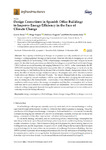Design Corrections in Spanish Office Buildings to Improve Energy Efficiency in the Face of Climate Change

Use este enlace para citar
http://hdl.handle.net/2183/36462
Excepto si se señala otra cosa, la licencia del ítem se describe como Creative Commons Atribución 4.0 Internacional CC BY
Colecciones
Metadatos
Mostrar el registro completo del ítemTítulo
Design Corrections in Spanish Office Buildings to Improve Energy Efficiency in the Face of Climate ChangeFecha
2020Cita bibliográfica
Orosa, J.A.; Vergara, D.; Fraguela, F.; Fernández-Arias, P. Design Corrections in Spanish Office Buildings to Improve Energy Efficiency in the Face of Climate Change. Infrastructures 2020, 5(12), 114. https://doi.org/10.3390/infrastructures5120114
Resumen
[Abstract] The majority of buildings in Europe are at present naturally ventilated and do not use heating or cooling equipment throughout the summer. However, this idea is changing and as a result heating ventilation air conditioning (HVAC) related energy consumption has been rising in the recent years. On the other hand, predictions published by the intergovernmental Panel on Climate Change (IPCC) indicate an annual warming rate ranging between 0.1 and 0.4 °C. In the present study, the ISO 13790:2011 standard has been employed to analyze the effect of building design corrections over the energy saving of a real building during its mean life and under climatic change predictions. In this sense, the effect of climate change, ventilation rate and its energetic and carbon dioxide emissions implications are obtained for the next 15 years. The results obtained indicate that an increment in the air changes by natural ventilation will be more effective than changing the wall structure and, in consequence, the thermal inertia. In particular, it was obtained that an increase of natural ventilation will always reduce the energy consumption and that this consumption will be lower with time due to an increment of an average outdoor air temperature. This modification will allow reduced cooling energy peak demands during the summer season and improve indoor ambiences in mild regions and the energy efficiency.
Palabras clave
Energy consumption
Office buildings
Climate change
Energy efficiency
Design corrections
Office buildings
Climate change
Energy efficiency
Design corrections
Versión del editor
Derechos
Creative Commons Atribución 4.0 Internacional CC BY






